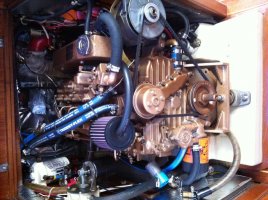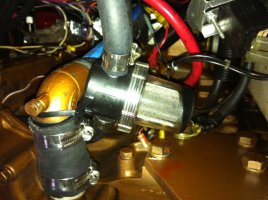Here's an experiment I've been doing for the past year that has turned out well so far...
On our E38-200 there was a crankcase breather hose (I think that's what it's called?) leading to the bilge. Over time it would collect oil and drip it into the bilge. A mechanic friend of mine suggested re-routing the hose to the air intake (common on other engines.) I did that by drilling a hole into the aftermarket filter (see pic). This kept the oil out of the bilge but made the filter more oily than I liked. After a while I found some expensive filters designed to separate the oil from the crankcase air being recirculated back to the engine. They were generally used on larger engines. The experiment was to emulate those filters by attaching a simple sea strainer at the low point of the hose routed between the crankcase and the air intake. It seems to work! Much of the oil is collected in the strainer leaving a much cleaner air filter. The oil in this pic is the amount after around 100hrs of use.
P.S. Please forgive the rats nest of wires in the background. These pics are from last year and the wiring has since been mostly cleaned up...
As always I'm open and grateful for feedback, especially if it prevents some unforeseen catastrophe...
NOTE- Not sure why the forum rotated the pics 90 degrees. They are straight on my desktop.


On our E38-200 there was a crankcase breather hose (I think that's what it's called?) leading to the bilge. Over time it would collect oil and drip it into the bilge. A mechanic friend of mine suggested re-routing the hose to the air intake (common on other engines.) I did that by drilling a hole into the aftermarket filter (see pic). This kept the oil out of the bilge but made the filter more oily than I liked. After a while I found some expensive filters designed to separate the oil from the crankcase air being recirculated back to the engine. They were generally used on larger engines. The experiment was to emulate those filters by attaching a simple sea strainer at the low point of the hose routed between the crankcase and the air intake. It seems to work! Much of the oil is collected in the strainer leaving a much cleaner air filter. The oil in this pic is the amount after around 100hrs of use.
P.S. Please forgive the rats nest of wires in the background. These pics are from last year and the wiring has since been mostly cleaned up...
As always I'm open and grateful for feedback, especially if it prevents some unforeseen catastrophe...
NOTE- Not sure why the forum rotated the pics 90 degrees. They are straight on my desktop.


Last edited:
